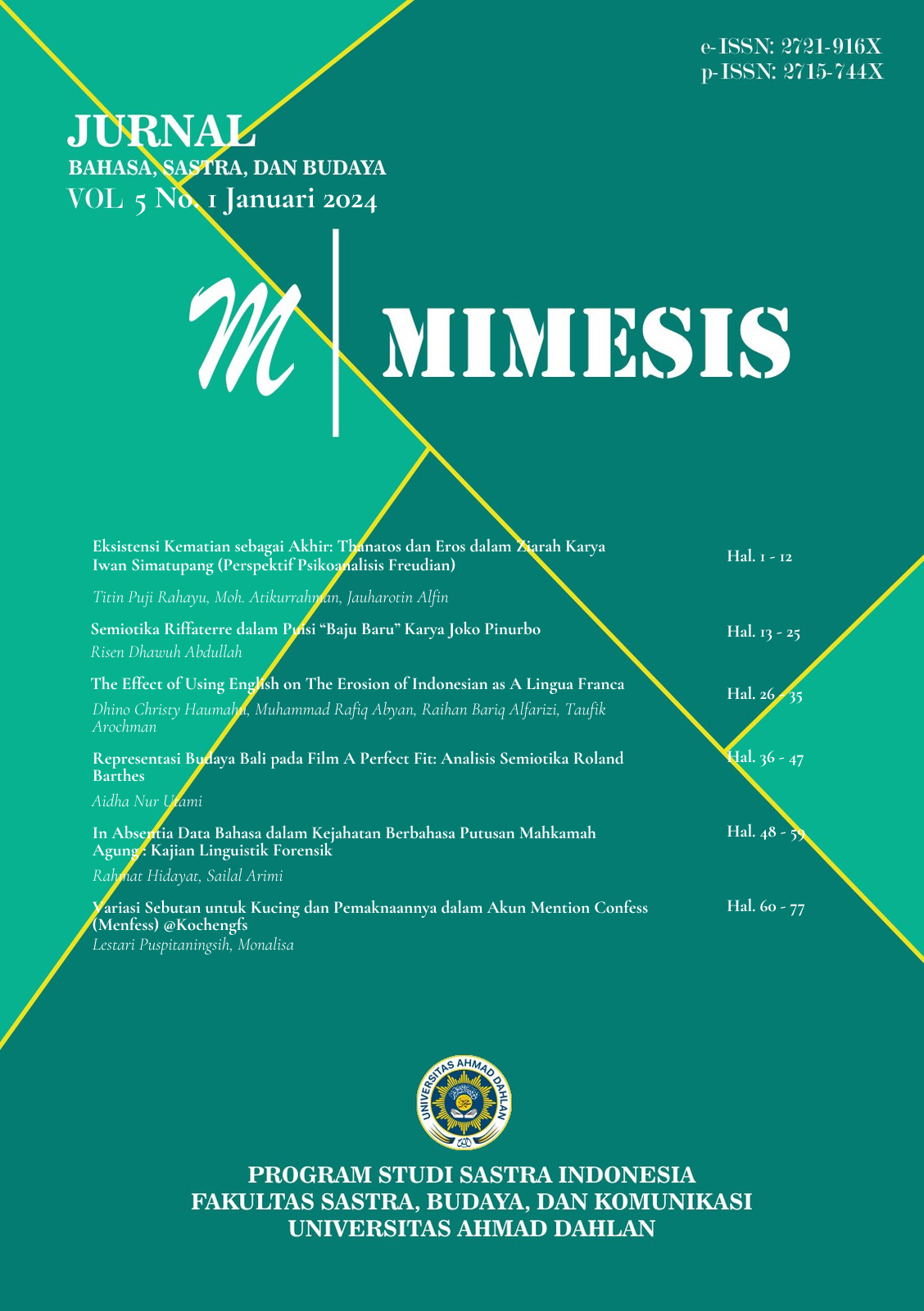Semiotika Riffaterre dalam Puisi “Baju Baru” Karya Joko Pinurbo
DOI:
https://doi.org/10.12928/mms.v5i1.8052Keywords:
Hermeneutics, Heuristics, Joko Pinurbo, Matrix, Models, Poetry, Riffaterre, Semiotics, VariantsAbstract
It is undeniable that poets often convey ideas with signs in the form of words, clauses, even sentences, thereby creating implicit or implicit messages. Studying a poem requires structural and semiotic analysis, because poetry is a structure of meaningful signs. Joko Pinurbo's poems contain many messages from deep anxiety. This study seeks to explain the meaning of related poetry according to Riffaterre's Semiotics theory. This research is a qualitative descriptive study. The material object in this research is a poem by Joko Pinurbo "Baju Baru". Meanwhile, the formal object is meaning based on language and literary conventions with Riffaterre's Semiotics theory which consists of heuristic readings, hermeneutic readings, as well as matrices, models and variants, hypograms. The results of the research through heuristic reading analysis found that fathers bought new clothes after payday because fathers' salaries increased. From the hermeneutic reading as a whole, the poem was created by the author as a form of outpouring of his heart as well as a form of criticism of the government for the phenomenon he is seeing, the increase in basic prices that afflict the lower class society, the matrix of the poem is a situation where basic needs soar, while workers' wages only increased slightly or even did not increase. The model of the poem is "gaji bapak" and "presiden". The variants consist of five variants. The first variant is "bapak gajian", the second variant is "reaksi si aku", the third variant is "perasaan presiden", the fourth variant is "kerusakan baju", the fifth variant is "keberadaan tukang becak dan presiden".
References
Abdullah, R. D. (2023). Makna “Celana” dalam Kumpulan Puisi “Selamat Menunaikan Ibadah Puisi” Karya Joko Pinurbo. Mimesis, 4(1), 96–103.
Dwipayanti, N. K., Mandala, A. K. U. D. A., & Dewi, P. T. K. (2021). Analisis Semiotika Riffaterre Dalam Lagu Sakura Karya Naotaro Moriyama. Jurnal Pendidikan Bahasa Jepang Undiksha, 7(2), 139–145.
Faruk. (2020). Metode Penelitian Sastra Sebuah Penjelajahan Awal (Cetakan ke-5). Pustaka Pelajar.
Hidayat, R., Nensilianti, N., & Faisal, F. (2021). Ketidaklangsungan Ekspresi dalam Kumpulan Puisi Buku Latihan Tidur Karya Joko Pinurbo: Pendekatan Semiotika Riffaterre. Indonesian Journal of Social and Educational Studies, 2(2), 139–155.
Huri, R. M., Hayati, Y., & Nst, M. I. (2017). Analisis Semiotika Riffaterre dalam Puisi Dongeng Marsinah Karya Sapardi Djoko Damono. Jurnal Bahasa Dan Sastra, 5(1), 52–66.
Joko Pinurbo. (2016). Malam Ini Aku Akan Tidur di Matamu. Grasindo.
Marahayu, N. M., & Widjatini, R. (2018). Semiotika Riffaterre dalam Puisi “Sajak Balsem untuk Gus Mus” Karya Joko Pinurbo. Pertemuan Ilmiah Bahasa Dan Sastra Indonesia (PIBSI), 281–292.
Pradopo, R. D. (2019). Pengkajian Puisi (Cet ke-16). Gadjah Mada University Press.
Ratih, R. (2017). Teori dan Aplikasi Semiotika Michael Riffaterre (Cet ke-2). Pustaka Pelajar.
Riffaterre, M. (1978). Semiotics of Poetry. Indiana University Press.
Siyoto, S., & Sodik, M. A. (2015). Dasar metodologi penelitian. literasi media publishing.
Thalib, A. A. (2018). Filsafat Hermeneutika dan Semiotika. Penerbit LPP-Mitra Edukasi.
Downloads
Published
Issue
Section
License
Copyright (c) 2024 Risen Dhawuh Abdullah

This work is licensed under a Creative Commons Attribution-ShareAlike 4.0 International License.
License and Copyright Agreement
In submitting the manuscript to the journal, the authors certify that:
- They are authorized by their co-authors to enter into these arrangements.
- The work described has not been formally published before, except in the form of an abstract or as part of a published lecture, review, thesis, or overlay journal.
- That it is not under consideration for publication elsewhere,
- That its publication has been approved by all the author(s) and by the responsible authorities tacitly or explicitly of the institutes where the work has been carried out.
- They secure the right to reproduce any material that has already been published or copyrighted elsewhere.
- They agree to the following license and copyright agreement.
Copyright
Authors who publish with Mimesis agree to the following terms:
- Authors retain copyright and grant the journal right of first publication with the work simultaneously licensed under a Creative Commons Attribution License (CC BY-SA 4.0) that allows others to share the work with an acknowledgment of the work's authorship and initial publication in this journal.
- Authors are able to enter into separate, additional contractual arrangements for the non-exclusive distribution of the journal's published version of the work (e.g., post it to an institutional repository or publish it in a book), with an acknowledgment of its initial publication in this journal.
- Authors are permitted and encouraged to post their work online (e.g., in institutional repositories or on their website) prior to and during the submission process, as it can lead to productive exchanges, as well as earlier and greater citation of published work.












